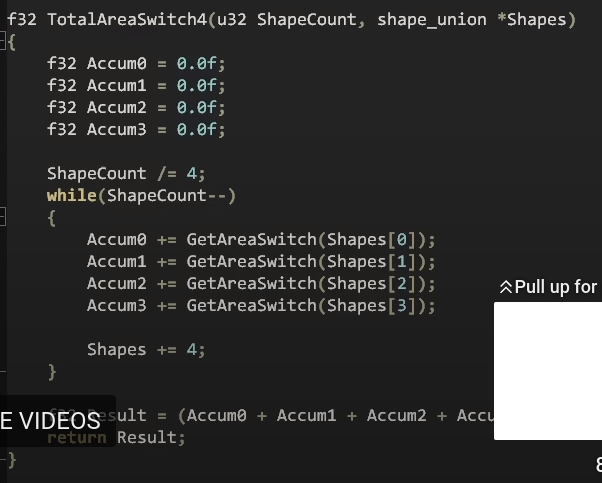My Comp and Comp II compressors use splines to generate the “soft kneed” in the gain curves. I also used them in Shaper to make a smooth asymmetrical distortion curve.
I find this guy super annoying. Also he’s really addressing a “straw man”. The real rule is always use clean code unless you have a good reason not to. And in a performance sensitive environment that might mean “but do whatever is fastest if it makes a difference”
What bugged me most is the dude’s “optimized” code only works if his number of shapes is divisible by 4. The 1…3 remaining shapes get excluded from the total.

Some of the optimization ideas presented here can have value in the right situations. But first you need a situation where you (a) have measured the performance, and (b) it is not good enough.
Sometimes people optimize things that don’t need it. Seriously, I had an argument once with a co-worker who “optimized” some code that ran once when you started up the program. Stop and think about THAT.
I put “optimized” in quotes because he had no idea how much time he was saving, because it was not possible to measure. I estimate 10 microseconds per program launch at best. This was a GUI, not some command line utility you could script. And the cherry on top was, his “optimization” added a bug to the code.
There is a very famous quote for Knuth about this: "premature optimization is the root of all evil.”
Knowing there are Process lasso users on this forum, i found very useful configuration tips on this video that solved crackling audio issues i had with Bitwig and VCV notably regarding audio processes priorities.
That was a lot of fun and took me back to my 3D game engine and 4D (3+1) CGI careers. I took advantage of techniques similar to those in this video by doing the complex calculations on the GPU using NVIDIA CUDA or DirectCompute and High Level Shader Language (HLSL) as massively parallel computing, in real-time. I typically created texture objects in R32G32B32A32 single precision floats RGBA format and use the texture object pointer to let the game engine such as Unity create the texture and let the GPU use the pointer and populate the texture and the the game engine to render the object, all by just passing pointers around.
Anyway… my Meander fractal Brownian motion (fBm) 4D correlated noise library derives from my CGI days of time and spatial correlated noise (motion), but my CGI days derived from my 1988 Meander “exponential smoothing” to introduce time correlated noise into musical motion.
These days, my CGI simulations of physics 10D “string theory” use these same techniques ![]()
And, I love the Monte Carlo simulations and sampling. I use a crude Monte Carlo as a binary space partition search algorithm on the CPU in Meander.
I first played around with a shareware program named POV-Ray back in the day when magazines came with cover mounted floppy disks. My PC at the time had a 386SX25 CPU, no maths coprocessor, which meant even the first demo of a ball on a flat surface took absolutely ages to render.
I got sidetracked into purely systems coding, but my student housemate went on to run what was for a time one of the biggest CG places in Europe, did CG rendering and motion capture for a heap of big movies and games, stuff like FIFA and Far Cry. Think they only used Maya, but from what I see now the big free platforms have taken over.
Tom Scott has filled YouTube with interesting videos and this is definitely one of them, all about the Forbes Pigment Collection at Harvard that houses compounds and other sources used by artists for colour over the centuries
That led me to this much longer talk
amazed to learn ultramarine cost as much as gold
Not surprisingly also having a couple of Audible Instruments Macro Oscillator 2 and Surge XT Twist VCO modules in front of me.
Fun to watch and think about. Scary to think of the level of commitment that would be required to master this. But, sort of fun scary ![]()
My ear can’t swallow those microtones ![]() But quite the instrument…
But quite the instrument…
Yeah, i’d get one just for the pretty lights.
That is one awesome machine. I think I’m in love. ![]()









